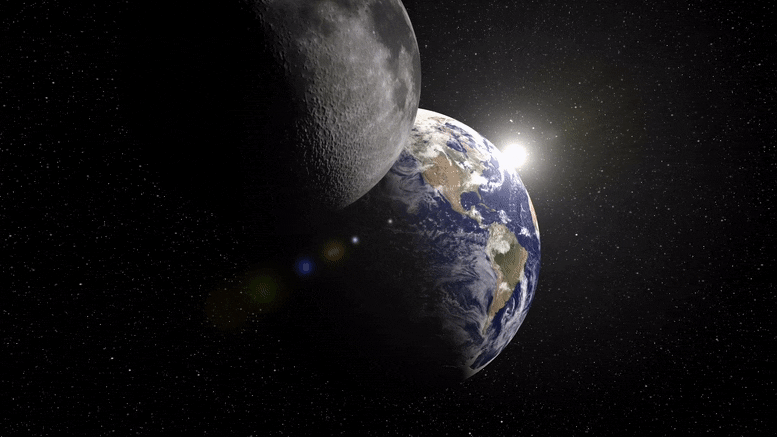
Para peneliti dari UAB, IFAE dan University College London mengusulkan menggunakan perubahan jarak Bumi-Bulan, yang dapat diukur dengan akurasi sub-sentimeter, sebagai detektor gelombang gravitasi baru dalam rentang frekuensi yang tidak dapat dideteksi oleh perangkat saat ini. Penelitian yang dapat membuka jalan untuk mendeteksi sinyal dari alam semesta awal baru-baru ini diterbitkan di Surat Verifikasi Fisik.
Gelombang gravitasi, yang diprediksi oleh Albert Einstein pada awal abad ke-20 dan pertama kali terdeteksi pada tahun 2015, adalah pembawa pesan baru dari proses paling kuat di alam semesta. Detektor gelombang gravitasi memindai rentang frekuensi yang berbeda, seperti menggerakkan dial untuk menyetel stasiun radio. Namun, ada frekuensi yang tidak dapat dicakup oleh peralatan saat ini dan yang mungkin mengandung sinyal dasar untuk memahami kosmos. Contoh khusus adalah gelombang mikrohertz, yang dapat diciptakan pada awal alam semesta kita dan hampir tidak terlihat bahkan oleh teknologi paling canggih yang tersedia saat ini.
Dalam sebuah artikel baru-baru ini yang diterbitkan di jurnal bergengsi Surat Verifikasi Fisik, peneliti Diego Blas dari Institut Fisika di Universitat Autònoma de Barcelona (UAB) dan Institut de Física d’Altes Energies (IFAE) dan Alexander Jenkins dari University College London (UCL) menunjukkan bahwa detektor gelombang gravitasi alami ada di dekat kita lingkungan: sistem bumi-bulan. itu[{” attribute=””>gravitational waves constantly hitting this system generate tiny deviations in the Moon’s orbit. Although these deviations are minute, Blas and Jenkins plan on taking advantage of the fact that the Moon’s exact position is known with an error of at most one centimeter, thanks to the use of lasers sent from different observatories which are continuously reflected upon mirrors left on the surface of the Moon by the Apollo space mission and others. This incredible precision, with an error of one billionth of a part at most, is what may allow a small disturbance caused by ancient gravitational waves to be detected. The Moon’s orbit lasts approximately 28 days, which translates into a particularly relevant sensitivity when it comes to microhertz, the frequency range researchers are interested in.
Similarly, they also propose using the information other binary systems in the universe may provide as gravitational wave detectors. This is the case of pulsar binary systems distributed throughout the galaxy, systems in which the pulsar’s radiation beam allows obtaining the orbit of these stars with incredible precision (with a precision of one millionth). Given that these orbits last approximately 20 days, the passing of gravitational waves in the microhertz frequency range affect them particularly. Blas and Jenkins concluded that these systems could also be potential detectors of these types of gravitational waves.
With these “natural detectors” in the microhertz frequency range, Blas and Jenkins were able to propose a new form of studying gravitational waves emitted by the distant universe. Specifically, those produced by the possible presence of transitions in highly energetic phases of the early universe, commonly seen in many models.
“What is most interesting perhaps is that this method complements future ESA/NASA missions, such as LISA, and observatories participating in the Square Kilometer Array (SKA) project, to reach an almost total coverage of the gravitational waves from the nanohertz (SKA) to the centihertz (LIGO/VIRGO) frequency ranges. This coverage is vital to obtaining a precise image of the evolution of the universe, as well as its composition”, Diego Blas explains. “Covering the microhertz frequency range is a challenge, which now may be feasible without the need of building new detectors, and only observing the orbits of systems we already know. This connection between fundamental aspects of the universe and more mundane objects is particularly fascinating and can eventually lead to the detection of the earliest signals we have ever seen, and thus change what we know about the cosmos”, he concludes.
Reference: “Bridging the μHz Gap in the Gravitational-Wave Landscape with Binary Resonances” by Diego Blas and Alexander C. Jenkins, 11 March 2022, Physical Review Letters.
DOI: 10.1103/PhysRevLett.128.101103
You may also like
-
Aturan matematika ditemukan di balik distribusi neuron di otak kita
-
Para ilmuwan menemukan penjelasan untuk lubang gravitasi raksasa di Samudra Hindia
-
Peta baru yang akurat dari semua materi di alam semesta dirilis
-
Para ilmuwan mengatakan sepasang bintang yang sangat langka berperilaku sangat ‘aneh’
-
Lima Angsa Tewas Setelah Terbang Ke Saluran Listrik Hinkley | Berita Inggris
